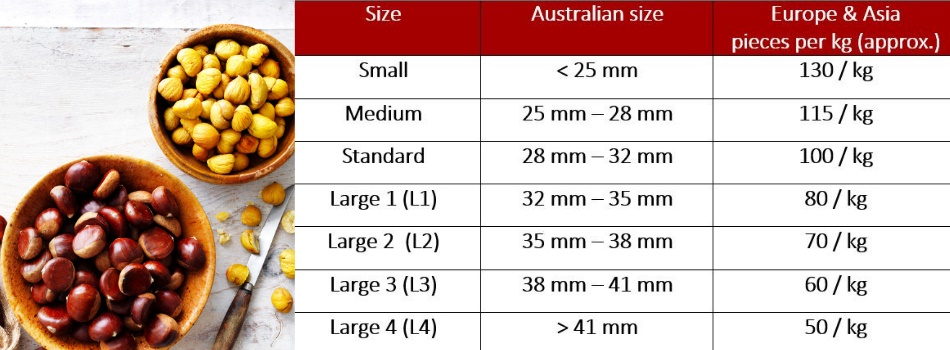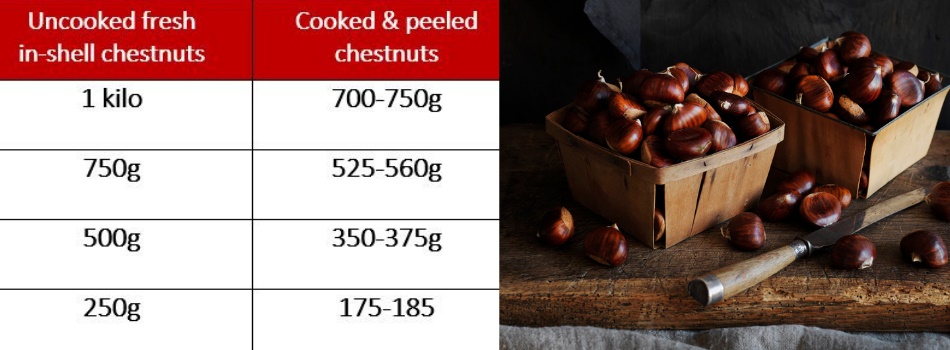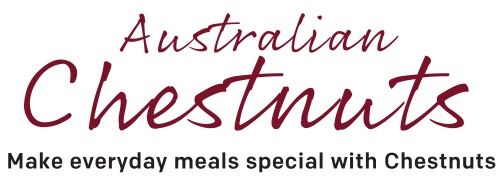
Australian Chestnuts
You’d be nuts not to try them!
Deliciously healthy and ultra-tasty, fresh Australian chestnuts are the most versatile ingredient in season
from mid-March until July and the perfect choice to add pizazz to your autumn and winter menus.
Australian chestnuts are quite different from other nuts, both nutritionally and in a culinary sense, so when the days get shorter and cooler, it’s time to enjoy chestnuts.
In 2018, over 1,100 tonnes of fresh chestnuts were harvested in Australia across approximately 300 chestnut orchards. With increased plantings and new high-yield varieties maturing this season, Chestnuts Australia President Adam Gatford believes that the 2019 chestnut season has never been a better time for Australians to make the most of Aussie chestnuts and encourages home cooks and chefs to discover chestnuts this season!
Chestnut know how
Select the best
The freshest chestnuts have glossy brown shells, and feel heavy for their size.
Chestnut sizes
In Australian chestnuts, there are seven sizes of chestnuts. The Australian industry standards grade chestnuts by the size of the hole that the nut can fall through. However, in Europe and Asia chestnuts are graded according to how many nuts there are in a kilogram.
Here are the Australian standards

Varieties
Like with most fresh produce, there are many different varieties of chestnuts, each has distinct characteristics. The four most-planted varieties are Red Spanish, Purton’s Pride, De Coppi Marone and Bouche de Betizac
Storing chestnuts
Fresh chestnuts due to their high moisture content (50%) can dry out even in a coolroom. For maximum shelf life store chestnuts in a coolroom as near as possible to 0°C in a sealed container or plastic bag. When stored correctly chestnuts remain in good condition for several weeks
Cooked chestnuts can be kept in an airtight container in the coolroom for up to 4 days. For extended storage, freeze chestnuts. Cook and peel chestnuts, place in small freezer bags and freeze for up to 6 months.
Cooking chestnuts
Preparation chestnuts
As chestnuts have a high moisture content, it is essential to cut the outer shell to enable the steam generated during cooking to escape, otherwise, chestnuts will explode, making quite a mess.
Boiling chestnuts
Cut fresh chestnuts in half across the width of the nut, then place in a pan of cold water and bring to the boil. Simmer for 15-20 minutes or until the flesh is tender and easily separates from the shell. To peel, remove one chestnut at a time from the water while still warm. Chestnuts will slip easily from their shells.
Roasting chestnuts
Preheat oven to 200°C (180°C fan-forced). Cut a shallow cross into the flat side of each chestnut shell. Place chestnuts on to a baking tray and bake for 15-20 minutes. Once cooked, remove chestnuts from the heat and wrap in a clean tea towel for 5 minutes. While chestnuts are still warm, quickly peel off the outer brown shell and papery casing.
Microwaving chestnuts
Cut a shallow cross into the flat side of each chestnut shell. Place 6 to 8 chestnuts in a single layer on a microwave-safe plate. Cook, uncovered, on full power (850 watts or High) for 2-3 minutes or until the flesh is tender. Timing may vary depending on chestnut size.
Chestnut yields
Once cooked, 1 kg of chestnuts yields approx. 700-750g of cooked and peeled chestnuts. Here is a rough guide for small quantities, weight varies slightly depending on the size of the chestnuts.

Chestnuts team deliciously with
The perfect partner for your sweet and savoury dishes go with savoury flavours like bacon, mushrooms, pumpkin, cauliflower, fennel, pasta, chicken, duck, beef, pork, sausages, pancetta, turkey, sage, potato, Brussels sprouts, thyme, onions, mushrooms, rosemary, cabbage, celeriac, cranberries, pear, apples, lentils, beans, rice and rosemary. For sweet combinations team chestnuts with chocolate, vanilla, coffee, maple syrup, dates, treacle, sugar, cream, custard, sugar, brandy, cinnamon, pears, dates, pastry, honey, rum.
Where are Australian chestnuts grown?
75% of Australian chestnuts are grown in North East Victoria around the townships of Beechworth, Stanley, Bright, Mt Beauty, Wandiligong and Myrtleford. The remaining crops are grown east of Melbourne in Victoria, in Batlow, Orange, Tenterfield and the Southern Tablelands in New South Wales, in the Adelaide Hills in South Australia, South West Western Australia and throughout Northern Tasmania.
Five reasons to go nuts for chestnuts this season
- Chestnuts Are A Delight For The Senses!
When it comes to aroma, taste and texture, chestnuts tick all of the boxes! When roasted and eaten straight from the shell the aroma is sweet, and a mouthfeel reminiscent of crispy roast potatoes with a soft centre. So easy and so delicious! - Chestnuts Are Incredibly Versatile!
Give chestnut a go; they are uniquely versatile and delicious. Chestnuts can be roasted, grilled, barbecued or boiled. Once cooked they can be used in a wide variety of different dishes. Served whole, halved, in pieces or pureed, the versatility of chestnuts stretches from hearty European stews and spicy Asian stir-fries to roast stuffings and creamy soups. Try adding chestnuts to ravioli fillings, meatballs or burger patties! - Chestnuts Are Delicious In Sweets Too!
Chestnuts are extremely multi-purpose and work equally well in savoury and sweet dishes. Try a chestnut and chocolate mousse, a creamy chestnut tiramisu or a chestnut cream perfect for layering between meringues, sponges and pastry or served with poached seasonal fruits. Try a fresh take on Power Balls with pureed dates, cacao, nuts, seeds and cooked chestnuts! - Chestnuts Are So Good For You!
There’s no denying the health benefits of chestnuts. These delicious seasonal nuts are low in fat and also offer a healthy dose of vitamin C, which is something you don’t get from other nuts! Chestnuts also provide folate, potassium, antioxidants, dietary fibre and are low in kilojoules with a 30 gram serve providing 217 kJ (52 Cal). - Chestnuts Are Gluten-Free!
Chestnuts are gluten-free making them a perfect addition to the diets of those with coeliac disease or a gluten intolerance. Use pureed chestnuts to thicken sauces, in casseroles and soups! Chestnut meal is also a useful replacement in baked products. Try this gluten-free chestnut and chocolate brownie recipe made with the ground chestnut meal!
